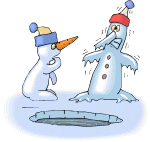

Polar Climate
 The polar regions are perpetually covered by snow and ice throughout the year. In these high latitude regions of the world, the Sun is never high enough in the sky to cause appreciable melting and the temperature rarely rises above freezing. During the long polar nights, which last six months at the poles, temperatures can fall to extremely low values. The lowest temperature ever recorded occurred in Antarctica, where a value of -88°C was reported.
The polar regions are perpetually covered by snow and ice throughout the year. In these high latitude regions of the world, the Sun is never high enough in the sky to cause appreciable melting and the temperature rarely rises above freezing. During the long polar nights, which last six months at the poles, temperatures can fall to extremely low values. The lowest temperature ever recorded occurred in Antarctica, where a value of -88°C was reported.
The north polar region includes the ice-covered Arctic Ocean, the Greenland continent and much of Northern Canada and Northern Siberia. In the Southern Hemisphere, the vast mountainous continent of Antarctic is covered by snow and compacted ice several kilometres thick.
Polar climates tend to be dry because the descending air is cold and lacks significant moisture, precluding the formation of clouds and snowfall. Some polar regions receive less than 10 inches or 250 millimetres of precipitation each year, and can be as dry as the hot deserts of the subtropical climate zone. The continental ice sheets of Greenland and Antarctica have taken many millions of years to form.
 | Polar climate |
Websites
Other topics
World Climates
World Climates
World Climates
Global Climate Maps
Global Climate Maps
Biomes
Introduction
Air Masses
Average Weather
British Climate
Climate Change
Climate Zones
Climatology
Continental Climate
Desert Climate
El Niño
General Circulation
Global Climate
Gulf Stream
Ice Sheets
Land & Sea
Latitude
Local Climates
Maritime Climate
Measuring Climate
Mediterranean Climate
Monsoons
Mountains
Oceans
Polar Climate
Pressure Patterns
Prevailing Winds
Rainfall Patterns
Regional Climates
Savannah
Seasons
Temperate Climate
Temperature Patterns
Tropical Climate
Wind Belts
 Print Topic
Print Topic